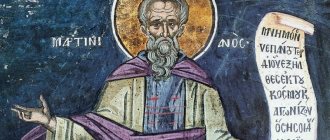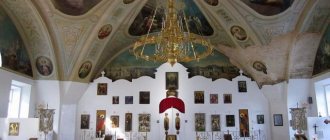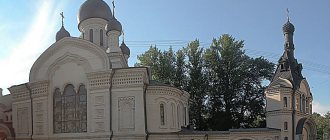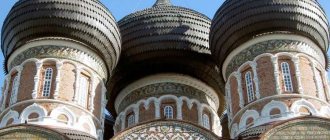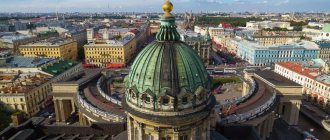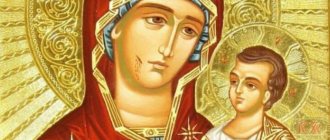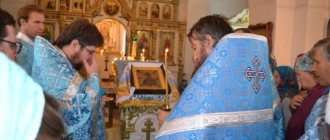There are many holidays in the church calendar in honor of the Mother of God icons: Kazan, Vladimir, Tikhvin and others. In honor of the icon of the Kazan Mother of God, two holidays were established: July 21 (July 8, old style) - in honor of the discovery , and November 4 (October 22, old style) - in honor of the deliverance of Moscow from the Poles . On November 4, the Church and citizens of Russia celebrate the autumn (winter) Kazan festival - a holiday in honor of the Kazan Icon of the Mother of God “deliverance for the sake of the reigning city of Moscow.”
Appearance of the miraculous Kazan Icon of the Mother of God
After a strong fire in Kazan in 1579, which destroyed most of the houses in the Russian part of the city, the Mother of God appeared in a dream to the ten-year-old girl Matrona and ordered her to dig up the ground under the burnt house and take the icon that was there. The girl told her parents about the miraculous appearance of the Mother of God, but the adults did not pay attention to her. The phenomenon repeated again, and Matrona and her mother went to the place where their house stood, and there, at a depth of about a meter, they found an icon. The fabric in which the image was wrapped was almost decayed, and the icon looked as if the icon painter had just finished his work. The icon was taken to the nearest church in front of a large crowd of people - the good news spread throughout the city. Miracles from the image were immediately revealed; several blind people regained their sight.
A witness to the miraculous appearance of the icon of the Mother of God and the healings that took place was the priest Ermolai, the future Patriarch Ermogen . He describes the event this way:
Show yourself the icon of the Mother of God in a gray form. Do not show the image of your Lady either to the saint of the city, or to the ruler of the ruler, lower than a noble or rich, lower than a wise old man: but show your honest treasure, an inexhaustible source to those who come with faith, your wonderful image, a certain man from the simple, who has wisdom in shooting war, This young woman, ten years old, has the name Matrona. This wonderful maiden appeared and the blessed icon of the Theotokos. And after the fire in the same year and month, this maiden began to appear to her, her name was before the river, the icon of the Blessed Mother of God. And he wounded her in hail and cheerful about the icon of the Bogoroditsyn, the same Vida, the archbishop and governors, so that they go to the image of the Most Holy Theotokos from the Earthly: And the very one, I, more, follow the shallow of the Dragago Biser, an honest treasure, the icon of the Bogoroditsyn.
Estimated place of finding the miraculous icon in Kazan
At first, the holiday was local, celebrated only in Kazan, but gradually numerous copies (copies) of the acquired image and its veneration spread throughout the Russian land: “Kazan Summer,” as it is popularly called, became church-wide. The holiday is dedicated to the discovery of the icon of the Blessed Virgin Mary in the city of Kazan and is celebrated on July 21.
Autumn Kazan and National Unity Day. history of the holiday
Often a church holiday is a remembrance of one or another event in Russian history, but in our time church and state holidays very rarely coincide. The church and state holiday in honor of the Kazan Icon of the Mother of God has become since 1649, when Tsar Alexei Mikhailovich ordered to celebrate not only the day of its appearance, July 8, but also October 22 (dates are indicated according to the old style - editor's note), in memory of the deliverance of Moscow and Russia from the Poles. It was celebrated for three centuries, until 1917. With the advent of Soviet power, the tradition of celebrating the liberation of Moscow was interrupted. But finally, the centuries-old holiday of the Russian Church again became a state holiday - on November 4, 2005, the Day of National Unity , known to all Orthodox Christians as “autumn Kazan Day,” was celebrated for the first time. Both the Church and the state remember one event on this day: the liberation of Moscow from the Poles in 1612, the end of the Time of Troubles.
Intercessor zealous Mother of God Most High
The Time of Troubles came, Moscow was occupied by foreigners. It seemed that the Russian state was coming to an end. Patriarch Ermogen , stood up to defend the state and the Orthodox faith . The first militia, assembled in 1611 by the Ryazan governor Prokopiy Lyapunov, was defeated, and the governor was killed by his own compatriots. Six months later, in Nizhny Novgorod, Kuzma Minin called on the townspeople to go to the defense of the Fatherland. Residents of other cities joined the Nizhny Novgorod residents, and the second militia under the leadership of Prince Dmitry Pozharsky and governor Kuzma Minin set out to liberate Moscow with a list (copy) of the miraculous icon of the Mother of God, revealed in Kazan in 1579.
According to legend, the decisive battle was preceded by a strict three-day fast and intense prayer. God's help was revealed, and on October 22, 1612, Moscow was liberated from the Poles. The civil strife of the Time of Troubles ended; in February 1613, the Zemsky Sobor elected Mikhail Fedorovich Romanov . Believing Russian people were convinced that victory over foreign invaders became possible thanks to the help of God and the miraculous image of the Mother of God. The veneration of the Kazan Icon of the Mother of God became nationwide.
Further, in 1812, M.I. Kutuzov prayed to the icon of the Kazan Mother of God immediately after his appointment as commander-in-chief. And on October 22, the day of the celebration of the Kazan Mother of God, Russian troops won their first victory over the French. The icon of the Kazan Mother of God is also credited with helping in the victory in the Great Patriotic War. According to legend, Marshal G.K. Zhukov carried the Kazan Icon to the fronts.
This fact is confirmed by his daughter, M. G. Zhukova, in the book “Marshal Zhukov: The Hidden Life of the Soul.”
The fate of the image of the Kazan Mother of God
The icon, revealed in 1579, remained in Kazan, in a monastery built on the site of its appearance. It was decorated with rich vestments - frames made of gold and precious stones. On the night of June 29, 1904, the icon was stolen by attackers. The police managed to detain the criminal; he turned out to be a certain Fyodor Chaikin , also known as Bartholomew Stoyan . At the trial, he admitted that he stole the icon because of its rich setting, and burned the image itself in the oven. Indeed, pieces of burnt fabric and jewelry that decorated the image were found. But later Chaikin himself, while in prison, said that he gave the icon to a person whose name he could not reveal even under the threat of death. Thus was born the legend that the icon is kept by the Old Believers . One of the versions, where the original image of the Kazan Mother of God is actually located, can be read in the article “The Secret of the Revealed Image.”
At the beginning of the 20th century, the Ministry of Internal Affairs conducted several investigations related to the “Old Believer trace” in the case of the Kazan Icon. Several times it seemed that the image was about to be discovered. There were witnesses who allegedly saw the icon in a secret underground prayer room and even participated in its movement. Thus, a certain prisoner Torshilov told investigators: “... the icon of the Kazan Mother of God is intact and is kept by the Old Believers in the prayer room, but it is very, very strictly guarded, so it is very difficult to take the icon from the prayer room.” But a thorough check of such testimony indicated the inconsistency of the information.
These rumors, however, have survived to this day. Relatively recently, journalists asked questions about the fate of the Kazan Icon to Metropolitans of the Russian Orthodox Church Alimpiy (Gusev) and Andrian (Chetvergov). Perhaps this is just a legend, but the Old Believers really revered and still reverence Kazanskaya. Almost every home has this image. And the procession with the miraculous Guslitsky icon continued even in the 60-70s.
History and meaning of the icon of the Kazan Mother of God
Our Lady of Kazan was found in 1579, after a devastating fire that destroyed a significant part of Kazan. According to legend, the Mother of God appeared in a dream to the little daughter of a local merchant, Matryona Onuchina, and showed her where to find the image. At the site where the icon was discovered, the Mother of God Convent was erected.
Special veneration of the Kazan Mother of God dates back to the 17th century, during the Time of Troubles. One of the inspirers of the patriotic movement, Patriarch Hermogenes, made this icon the main symbol of the struggle against the invaders. Since then, Our Lady of Kazan has often been turned to for help when Russia was in danger - this was the case before the Battle of Borodino in 1812.
At the beginning of the 20th century, the image was stolen by Bartholomew Stoyan. However, the testimony of the robber himself varies; some inhabitants of the Bogoroditsky Monastery, where it was kept, claimed that the list was stolen, not the original. Currently, a copy of the icon from the second half of the 18th century is kept in Kazan.
Feast of the Kazan Icon of the Mother of God. Divine service
It is believed that it was Patriarch Hermogen who wrote the service for the feast of the appearance of the Kazan Icon of the Mother of God . “O zealous intercessor, Mother of the Lord Most High, pray for all Your Son, Christ our God...” says the troparion for the holiday.
Troparion, tone 4.
O zealous intercessor, Mother of the Lord Most High, pray for everyone to Your Son, Christ our God, and grant to all those who seek refuge in Your sovereign protection to be saved. And intercede for all of us, O Lady Queen and Lady, who, in adversity and sorrow, and in illness, are burdened with many sins, coming and praying with a tender soul and a contrite heart, to Your most pure image, miraculous icons with tears, and those who have irrevocable hope in You, get rid of all evils. And grant useful things to everyone, and save everything to the Virgin Mary. For You are the Divine protection of Your servant.
Kontakion, tone 8.
People come to this quiet and good refuge, the quick Helper, the ready and warm salvation of the Virgin’s cover. Let us hasten to prayer and strive to repent. The Most Pure Mother of God exudes abundant mercy for us, comes to our aid, and delivers Her well-behaved and God-fearing servants from great troubles and evils.
Library of the Russian Faith Canon to the Appearance of the Icon of the Blessed Virgin Mary in the City of Kazan →
Read online
Prayer to the Most Holy Theotokos in front of Her icon called “Kazan”
O Most Holy Lady Lady Theotokos! With fear, faith and love, before Thy honorable icon, we pray to Thee: do not turn Thy face away from those who come running to You, beseech the Merciful Mother, Thy Son and our God, the Lord Jesus Christ, that He may keep our country peaceful, and may He establish His Holy Church. will preserve the unshakable from unbelief, heresies and schism. There are no imams of any other help, no imams of other hope, except You, Most Pure Virgin: You are the All-Powerful Helper and Intercessor of Christians. Deliver all those who pray to You with faith from the falls of sin, from the slander of evil people, from all temptations, sorrows, troubles and from vain death: grant us the spirit of contrition, humility of heart, purity of thoughts, correction of sinful lives and remission of sins, and let everyone praise greatness with gratitude. Yours, let us be worthy of the Heavenly Kingdom and there, with all the saints, let us glorify the Most Honorable and Magnificent Name of the Father and the Son and the Holy Spirit. Amen.
Folk traditions of the holiday of the Kazan Icon of the Virgin Mary
The Feast of the Kazan Icon of the Mother of God has always been an important date in the folk calendar.
This day was considered the boundary between autumn and winter. People said: “Go to Kazanskaya on wheels, and put the runners in the cart,” “Mother Kazanskaya leads a snow-free winter, shows the way to the frosts,” “It’s not winter before Kazanskaya, but it’s not autumn from Kazanskaya.” During this period, the peasants were finishing their seasonal construction work. In the old days, the Autumn Kazanskaya was always the time for settlements, the agreement “To Kazanskaya - settlement!” no one dared to disturb, they were also afraid of the coming cold weather.
The holiday of the icon of the Kazan Mother of God is considered one of the most important women's holidays. The Kazan icon has long been considered a female intercessor. Belated weddings were also timed to coincide with this holiday, as there was an ancient belief: “Whoever marries Kazanskaya will be happy.”
Icons of the Kazan Mother of God
The icon of the Kazan Mother of God is one of the most revered; it belongs to the Hodegetria type, which means “showing the way.” According to legend, the prototype of this icon was painted by the Apostle Luke . The main dogmatic meaning of this icon is the appearance into the world of the “heavenly King and Judge.” The Mother of God is depicted with her breasts up, in characteristic clothes, with her head slightly tilted towards the Child. The Child Christ is presented strictly from the front, the figure is limited to the waist. On the icon revealed in Kazan, Christ blesses with two fingers, but in some later copies there is a naming finger. Most often, the Kazan Icon is asked for deliverance from eye disease, invasion of foreigners and help in difficult times.
Kazan Icon of the Blessed Virgin Mary. List from Yelokhovsky Cathedral
One of the oldest existing lists of the Kazan icon. 16th or 17th century, in chasuble of 1881. Yaroslavl Museum Kazan Icon of the Virgin Mary. List from the Kazan Cathedral in St. Petersburg
Icon with the Kazan Icon of the Mother of God in the Church of the Yaroslavl Wonderworkers in Kazan. Presumably this is a list from the mid-18th century
Lists of holy images
At the beginning of the 20th century, the miraculous icon that appeared in Kazan was stolen by robbers, the precious frame was plundered, and the shrine itself disappeared without a trace. During the entire period of veneration of the holy image, many copies were made from it, which also became famous as miraculous.
After the terrible revolutionary turmoil of 1917, these lists were distributed throughout the world, and the whole world already believed in the miracles that prayer works before the icon of the Kazan Mother of God.
Today, the Russian Orthodox Church is making every effort to return shrines to Russian land; the oldest copy of the Kazan icon can be seen in the Tretyakov Gallery.
Another new phase in the history of the icon of the Most Holy Theotokos in Kazan occurred in 2004. His Holiness Patriarch Alexy contacted Pope John Paul II to discuss the icon discovered in the papal court in 1993. It is known that such an act of the Pope was another step in resolving Christian conflicts between faiths. But, regardless of his motives, he returned a long-lost sanctuary to our country. Later it turned out that this was not the original icon that appeared in Kazan, but it was a very ancient copy, probably from the original. The icon, adopted in 2004, is now kept in Kazan in the Church of St. Exaltation of the former monastery of the Mother of God, where the first icon was lost.
Copies of the miraculous icon became especially famous for their healings from blindness and eye diseases. This icon is also considered an indispensable helper in difficult and war times.
Temples in honor of the Kazan Icon of the Mother of God in Rus'
In honor of the discovery of the holy image of the Mother of God in 1579, by decree of Ivan the Terrible, the Kazan Mother of God Monastery . The first nun, and then the abbess of this monastery, was Matrona Onuchina (who took the name Martha) and her mother. First, a log church was founded - the predecessor of a large stone cathedral, which was erected in 1595. In the post-revolutionary period, the cathedral shared the fate of most church buildings: at first it was nationalized and used for economic needs, and then blown up. And now, in 2021, work begins on its reconstruction.
Kazan Mother of God Monastery on an engraving by E. Tournerelli. Early 19th century
Soon after the victory over the Poles, a temple was built in Red Square in Moscow in honor of the Kazan Icon of the Mother of God . The “Historical Guide to Moscow” (1796) states that this temple, then still wooden, was built in 1625 at the expense of Prince Dmitry Pozharsky. Earlier sources know nothing about this church, which allegedly burned down in 1634. What followed was a very complex construction history of the Kazan Cathedral.
Cathedral of the Kazan Icon of the Mother of God on Red Square (Moscow). Naydenov N. A. 1883
The Kazan Cathedral is the first of the Moscow churches completely lost during Soviet times, which was recreated in its original forms. It is worth noting that the Kazan Cathedral played a significant role in the history of the Old Believers: it was here that Archpriest John Neronov , and later Archpriest Avvakum, who came to him, served as rector.
Kazan Cathedral on Red Square. Built in the 1990s. Modern look
In 1649, Tsar Alexei Mikhailovich issued a decree establishing church-wide veneration of the image of the Mother of God revealed in Kazan. The consequence of this decree was the construction of a brick church in the Yaroslavl convent, as well as a temple of the icon of the Kazan Mother of God in Kolomenskoye , a village near Moscow, where the wooden royal palace was located. This five-domed brick church, decorated with a hipped bell tower, has survived to this day almost unchanged.
Temple of the Icon of the Kazan Mother of God in Kolomenskoye. Modern look
In honor of the Kazan Icon of the Blessed Virgin Mary, a church was consecrated in the city of Murom, Vladimir Region . The Kazan Church in ancient acts is known under the name of “Nicholas of Mozhaisky”. The first mention of this church dates back to 1574. In 1630 the church burned down. After some time, the temple was rebuilt. The church was closed by decree of the All-Russian Central Executive Committee of January 20, 1930, and demolished in 1936.
Kazan Church in Murom
, the gate church of the Trinity Monastery in the city of Murom, Vladimir Region, was consecrated . The church was built in 1648. The dimensions of the church are miniature. In terms of plan, it is half the size of Trinity Church. The outer size, including the altar part, is only 2.5 fathoms. However, due to the fact that the church is raised above the “gates”, which serve as the main entrance to the monastery, and also due to the tented composition, unusual for this time, the Kazan Gate Church is not inferior to the Trinity Church.
Kazan Church of the Trinity Monastery in Murom
In honor of the Kazan Icon of the Most Holy Theotokos, a church was consecrated in Moscow, on Bolshaya Dmitrovka . In the middle of the 17th century, a second, “warm” church appeared in the St. George Monastery - in honor of the Kazan Icon of the Blessed Virgin Mary with the chapels of St. Alexis the Man of God and St. Catherine. The temple dates back to 1652. The temple was destroyed in 1935 and a four-story standard school building was built in its place.
Kazan Church in Moscow, on Bolshaya Dmitrovka
In honor of the Kazan Icon of the Blessed Virgin Mary, a church was consecrated in the village of Yurino, Balakhninsky district, Nizhny Novgorod region . The church was built in the 17th century. The church underwent reconstruction in 1998.
Kazan Church in the village of Yurino, Balakhninsky district, Nizhny Novgorod region
Kazan icon. How does the Kazan Icon of the Mother of God help?
Days of Remembrance (new style): July 21 - “Summer Kazan” - the miraculous discovery of the Kazan Icon. November 4 - “Autumn Kazan” - in honor of the victory of the Russian militia, led by Dmitry Pozharsky and Kuzma Minin, in the war with the Polish invaders.
What do they pray for in front of the Kazan Icon? The history of the discovery of the Kazan Icon of the Mother of God. Prayers to the Mother of God in front of her Kazan Icon. Akathist to the Blessed Virgin Mary in front of her Kazan Icon. The Greatness of the Kazan Icon. Video about the Kazan Icon of the Mother of God.
WHAT DOES THE KAZAN ICON OF THE MOTHER OF GOD HELP WITH?
Prayers in front of the image of the Kazan Icon of the Mother of God can help you in many matters in life, and besides, they pray to Her in times of despondency, sadness and disaster, when there is no longer enough strength to fight adversity. With the help of prayers in front of the image of the Kazan Mother of God, you can be cured of any disease, especially eye diseases and even blindness, not only physical, but also spiritual. The image of the Mother of God and prayers to Her help to find the right solution to complex issues. For many centuries, people placed the “Kazan” icon near a child’s crib, knowing that the Mother of God would look after the child and protect him, if necessary. Also, since ancient times, the Kazan Icon has been used to bless newlyweds for a long and happy life. And, if the wedding falls on the day of the celebration of this icon, family life should be long and happy.
It must be remembered that icons or saints do not “specialize” in any specific areas. It will be right when a person turns with faith in the power of God, and not in the power of this icon, this saint or prayer. Which saints and who should we pray to on different occasions and why our prayers remain unanswered.
DISCOVERY OF THE KAZAN ICON OF THE MOTHER OF GOD
The miracle of the discovery of the Kazan Icon of the Mother of God occurred on July 8, 1579, several decades after Ivan the Terrible conquered the Kazan Khanate. In June 1579, there was a big fire in Kazan, which destroyed a significant part of the city’s wooden buildings, and half of the Kazan Kremlin burned down. Muslims rejoiced at the troubles and said that this Russian God was angry with Christians. But, as usually happens with God’s providence, the fire actually became the beginning of the spread of Orthodoxy in the Khanate. The house of archer Daniil Onuchin, who was planning to build a new home in the same place, was also damaged in the fire. The work had almost begun, but his daughter Matrona, who was then ten years old, had a dream of the appearance of the Mother of God Herself, who indicated the place where Her icon lay under a layer of earth, which was thus hidden by Orthodox confessors in order to protect the image from desecration by Muslims . The Mother of God ordered to find this icon, but no one paid attention to the girl’s words; the adults were busy with their own affairs. Three times the Holy Mother appeared to Matrona, again and again She indicated the place where the miraculous icon was hidden. The girl still managed to persuade her mother to help in the search, and finally they began to dig together in the indicated place. And a miracle happened, the icon was found! All the clergy arrived at the place where the shrine was miraculously found. Archbishop Jeremiah took the found image of the Mother of God and solemnly transferred It to a nearby church in the name of St. Nicholas, and from there, after serving a prayer service, the shrine was transferred by procession to the very first Orthodox church in Kazan, which was built by order of Ivan the Terrible. Immediately, the Kazan Icon of the Mother of God began to work miracles; during the procession of the Cross, two blind men, Nikita and Joseph, regained their sight. The newly found icon of the Mother of God very soon became a national shrine, because in this way Holy Mary showed a sign to the entire Russian Church. More than once, “Kazanskaya” showed the way to glory and victory for Orthodox soldiers, defenders of the Russian land, who fulfilled their duty to God and the Motherland.
While defending Rus' from the atrocities of the Poles, Prince Dmitry Mikhailovich Pozharsky began to gather an army. In Yaroslavl, Kazan warriors with the Kazan icon (with its copy), which they handed over to the prince, also joined the militia. With the icon and prayers of the Mother of God, the Russian army moved towards the capital. And at this time, in Moscow captured by the Poles, the captured Greek Archbishop Arseny († 1626; April 13) was located. One night a bright light appeared in his cell and he saw St. Sergius of Radonezh. The saint told Arseny that the Mother of God had interceded for our Fatherland and soon, by God’s mercy, Russia would be saved. The Most Holy Theotokos took the Russian troops under Her protection, with Her help, two days later the Poles were expelled from the Kremlin and defeated, and through Her intercession Rus' was saved.
The day after this victory, in gratitude for the help in expelling the enemies, a procession of the cross was made with the miraculous Kazan Icon, to meet which Archbishop Arseny came out of the Kremlin. In his hands he held the miraculous Vladimir Icon of the Mother of God, which he had preserved in his captivity. According to the descriptions, all the people knelt before the image of their Intercessor.
After the Polish invaders were expelled from Moscow, Dmitry Pozharsky installed the holy Kazan icon in the Church of the Entry into the Temple of the Blessed Virgin Mary, which was located in Moscow on Lubyanka. After some time, the prince began to build the Kazan Cathedral on Red Square and in 1636, when the cathedral was erected, the shrine was moved to a new location. November 4 (October 22, old style) was declared the day of celebration of the Kazan Icon of the Mother of God in memory of the liberation from the Poles. At first this day was celebrated only in Moscow, but since 1649 this holiday became a state holiday.
Before the battle of Poltava, Peter the Great prayed before the icon of the Kazan Mother of God (in the village of Kaplunovka). In 1812, the Kazan Icon of the Mother of God was given protection to Russian soldiers who defended Russian soil from French invaders. The first major military success of Russian soldiers in this war happened just on the holiday of the “autumn” Kazan icon; on this day (October 22, old style) the rearguard of the French army was defeated, Napoleonic army lost about seven thousand of its soldiers. During the Great Patriotic War of 1941-1945. The miraculous image of the Kazan Icon was carried in a religious procession in besieged Leningrad; a prayer service was served before the icon in Moscow, after which the icon was taken to Stalingrad. Where the miraculous icon was located, the enemy was defeated. This icon is revered throughout Russia; there is not a single church where there is not a Kazan Icon. This image has been revered at all times, and if there is an image of the Mother of God in a family that is passed down by inheritance, in most cases it will be the Kazan Icon of the Mother of God. Now this miraculous icon has been located in the Epiphany Patriarchal Cathedral in Moscow.
The Kazan Tobolsk Icon of the Mother of God was found in 1661 and is located in the city of Tobolsk in the cathedral church. The story of the acquisition of this icon is as follows.
Hierodeacon Ioannikios had the appearance of John Chrysostom, who revealed to him that in the closet of the Church of the Three Hierarchs, facing the wall, there was an image of the Kazan Mother of God. By the command of God, they must build a church nearby in honor of this icon, consecrate it and bring it into the new church as a throne one. But the hierodeacon did not tell anyone about this vision. After some time, the saint visited him again and asked him why he did not tell the archimandrite about this. After this question, the vision disappeared, and the hierodeacon himself fell to the ground out of fear, glorified God, but was still afraid to say about it, “so that there would not be confusion among the people, and for fear that they would not believe.” He did not mention this even after the next, third vision of the saint. And during the feast of the Kazan Icon, at Matins, Hierodeacon Ioannikiy suddenly lost consciousness and fell. As he later said, among the people he again saw the saint, who said:
“You read this and why don’t you believe it yourself? That image was in the ground, and this one stands in the porch facing the wall; why didn’t you tell about him?”
And he, shaking his hand at me, said:
“From now on, be decrepit until the divine work is completed.”
Having said this, he became invisible, and I fell to the ground out of fear and now I’m telling you.”
After people found out about this, they immediately paid homage to the Mother of God, consecrated the icon and built a church. The narrator noted that until that moment there had been rains that flooded the fields, the rivers began to overflow, like in spring, flooding houses, but as soon as they began to build the temple, everything calmed down, “the bread and vegetables have gotten better since then.”
The Kaplunovskaya Kazan Icon of the Mother of God is located in the village of Kaplunovka, Kharkov region. In 1689, a gray-haired old man appeared in a dream to the pious priest of this village, John Umanov, who ordered him to buy from the Moscow icon painters, who would soon arrive, the eighth Kazan icon of the Most Holy Theotokos.
"From her you will receive mercy and grace"
- said this old man. After the icon was purchased, the Mother of God herself appeared to the priest in a dream and ordered to place this icon in the temple. John told the people about this and all the people triumphantly fulfilled this command. After this, miracles began to happen from this icon. In 1709, Emperor Peter I, before the battle with the Swedes, prayed to the Mother of God for help to this particular image; this icon was carried in front of all the regiments. According to legend, Swedish soldiers tried to burn down the Kaplunovskaya church, but were unable to do so. And then Karl said:
“If they couldn’t light the church without an icon, then where it is located will be unsafe for us.”
That’s how it all happened, the Russian people won the Battle of Poltava.
The Nizhnelomovskaya Kazan Icon appeared in 1643 near the city of Nizhny Loma, Penza region. First, a chapel was built on this site, and later a monastery was founded here.
The Ascension Kazan Icon is located in the Moscow Ascension Convent, in the Kremlin. The icon was glorified for the first time in 1689. After the prayer service to the image of Kazan, the candle was not extinguished. It fell and started a fire, which burned the lectern, but the icon itself, despite the fact that it was painted on canvas, was not damaged. In 1701, there was a big fire from which the Ascension Monastery burned down, but the icon itself was not damaged at all. At the same time, she herself miraculously found herself first among the removed icons, and then, after the fire, she independently, without anyone’s help, found herself back in her place. In addition, many healings occurred from this icon.
The Pavlovsk Kazan Icon is located in the village of Pavlovskoye, Moscow province, Zvenigorod district. Her appearance took place near the village, on a tree, next to which a chapel was built. The first miracle immediately happened from this icon, the healing of a peasant who had become very ill as a result of his sinful life. The Mother of God appeared to his neighbor in a dream and said that the sick man could recover if he stopped sinning in his life and went to the holy well and washed himself with holy water. With great difficulty, the patient reached this well, washed himself, and immediately recovered.
The Yaroslavl image of the Kazan Icon is located in the Kazan Convent of the city of Yaroslavl. In 1588, the pious man Gerasim wished to purchase an icon of the Mother of God, after which he had a miraculous vision of the Mother of God, who told him where it needed to be done and what needed to be done next. When Gerasim found this icon, immediately after he took it in his hands, he was immediately healed from the illness that had tormented him for a long time. Then he went, according to the instructions of the Mother of God, to the city of Romanov, where he handed over this icon to its inhabitants with the condition that a temple be erected for it. The church was built and the icon was in it until 1604, when the city was taken by the Lithuanians. Then the miraculous icon was transported to Yaroslavl, where a temple was erected in honor of the Mother of God, and later a monastery. The residents of Romanov wanted to return the icon to themselves, and wrote a petition to Tsar Vasily Ioannovich. But the residents of Yaroslavl also wanted to keep the shrine for themselves. Then an exact list of the icon was made for the residents of Romanov, and the miraculous icon itself is carried annually in a religious procession from Yaroslavl to Romanov.
In addition to these listed icons, there are many more images and lists of the Kazan Icon of the Mother of God, and in any of them the Mother of God will show us her love and protection in the face of any troubles, is our Comforter in our sorrows and rejoices with us in our joys.
THE GREATNESS OF THE VIRGIN BEFORE HER ICON OF KAZAN
We magnify You, Most Holy Virgin, God-chosen Youth, and honor Your holy image, through which you bring healing to all who come with faith.
VIDEO ABOUT THE KAZAN ICON OF THE MOTHER OF GOD
Icon of the Mother of God Burning Bush
Share:
Old Believer churches in honor of the Kazan Icon of the Mother of God
Twice a year, in summer and autumn, ceremonial services are held in Old Believer churches. Many of them were consecrated in honor of this holiday. First of all, these are the Belokrinitskaya, Pomorskaya and Fedoseevskaya communities of Kazan.
Church of the Russian Orthodox Church in honor of the Kazan Icon of the Mother of God. Kazan
Patronal feast day today in the communities of the Russian Orthodox Old Believer Church in Samara, Biysk, the villages of Slobodishche and Gubino in the Moscow region, the villages of Bolshoye Nepryakhino, Bezvodnoye, Fedurino in the Nizhny Novgorod region, the village of Pustyn in the Kostroma region, the village of Primorskoye in the Odessa region and other cities and villages of Russia, Ukraine and Romania . In two monasteries of Belokrinitsky consent, today is also a patronal holiday: in the village of Kunicha (Moldova) and the village of Russkaya Slava (Romania).
Temple of the Kazan Icon of the Mother of God. Slobodishche (Moscow region)
Temple in the name of the Kazan Icon of the Blessed Virgin Mary of the Old Believer Convent in the village. Kunicha (Moldova)
Temple of the Kazan Blessed Virgin Mary. Primorskoe (Odessa region)
The patronal holiday is for the temple and monastery of the Russian Ancient Orthodox Church in the village of Filippovskoye, Nizhny Novgorod region (Malinovsky monastery) and in the Pomeranian communities of Samara, Barnaul, Naryan-Mar, Rybinsk, the city of Novograd-Volynsky, Zhitomir region (Ukraine) and the city of Bobruisk (Belarus).
Kazan Church of the Russian Children's Center in the village of Filippovskoye, Nizhny Novgorod region
Summer celebration of the icon of the Kazan Mother of God
The Day of the Kazan Icon of the Mother of God is celebrated by Orthodox Christians twice a year: in the summer - on July 21 - in memory of the appearance of the icon in Kazan, and on November 4 - in gratitude for the deliverance of all of Rus' from the Polish invaders.
The miraculous discovery of the Kazan Icon of the Mother of God
At the end of the 16th century, a terrible disaster struck Kazan. The fire that started in the church spread to houses and the Kremlin, many buildings and houses burned down. More than one Kazan family was left homeless, which became the reason for mockery of the Christian faith from non-believers: “Where was your God? Why did you let the houses burn down?”
And indeed, many on that terrible summer night doubted the Orthodox faith and the one God. However, while summer was still around, they urgently began to rebuild the burnt houses. One such night, in the midst of restoration work, the archer’s daughter Matrona saw in a dream the image of the Mother of God, who told her to get the icon with the holy face out of the ground, and showed her the place in the dream.
The miraculous image was indeed found in that place. Once brought to light, the icon began to work miracles. The holy face was solemnly transferred to the Temple with the procession of the Cross; during the transfer of this icon, two blind people received their sight, who really wanted to look at the miracle that had appeared in the world.
From that moment on, even those who mocked and mocked the true faith rushed to the icon with requests for healing and admonition. From that memorable day, the prayers of the Kazan Icon of the Mother of God began to work real miracles according to the faith of those asking. In the place where the icon was found, a convent was erected, in which many true believers Orthodox girls and women were tonsured and served the Lord and the world with prayers and sacrifices.
